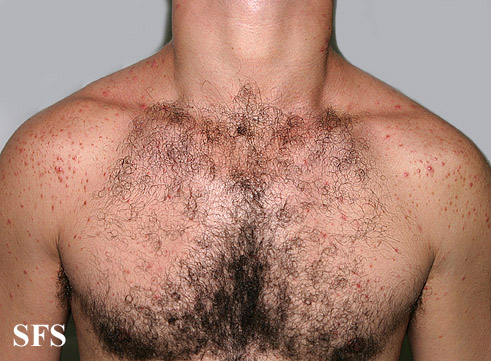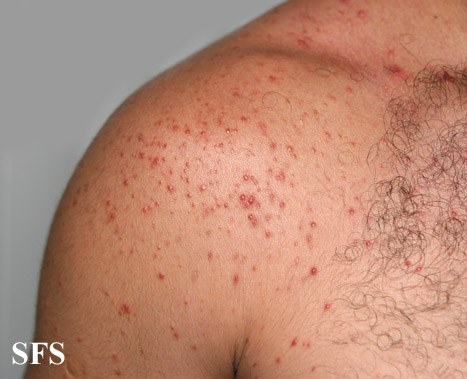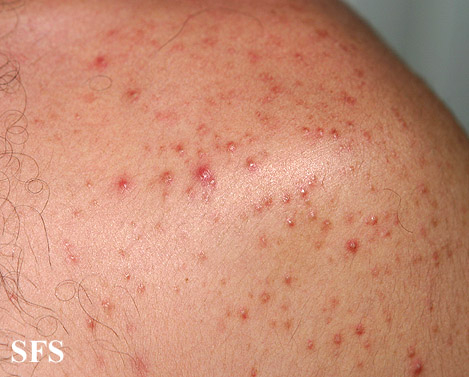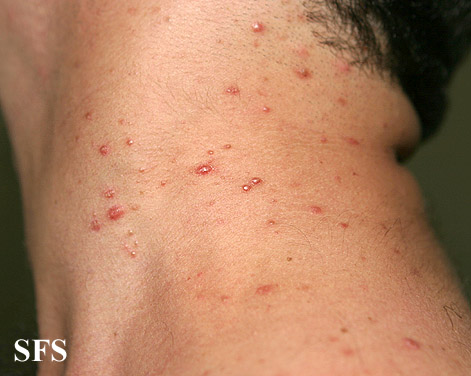Malassezia
|
WikiDoc Resources for Malassezia |
|
Articles |
|---|
|
Most recent articles on Malassezia |
|
Media |
|
Evidence Based Medicine |
|
Clinical Trials |
|
Ongoing Trials on Malassezia at Clinical Trials.gov Clinical Trials on Malassezia at Google
|
|
Guidelines / Policies / Govt |
|
US National Guidelines Clearinghouse on Malassezia
|
|
Books |
|
News |
|
Commentary |
|
Definitions |
|
Patient Resources / Community |
|
Patient resources on Malassezia Discussion groups on Malassezia Patient Handouts on Malassezia Directions to Hospitals Treating Malassezia Risk calculators and risk factors for Malassezia
|
|
Healthcare Provider Resources |
|
Causes & Risk Factors for Malassezia |
|
Continuing Medical Education (CME) |
|
International |
|
|
|
Business |
|
Experimental / Informatics |
Editor-In-Chief: C. Michael Gibson, M.S., M.D. [1]; Associate Editor(s)-in-Chief: Jesus Rosario Hernandez, M.D. [2].
Synonyms and keywords: Pityrosporum.
Overview
Malassezia (formerly known as Pityrosporum) is a genus of fungi. Malassezia is naturally found on the skin surfaces of many animals, including humans. In occasional opportunistic infections, some species can cause hypopigmentation on the trunk and other locations in humans. Allergy tests for this fungus are available.
Nomenclature
Due to progressive changes in their nomenclature, some confusion exists about the naming and classification of Malassezia yeast species. Work on these yeasts has been complicated because they are extremely difficult to propagate in laboratory culture.
Malassezia were originally identified by the French scientist Louis-Charles Malassez in the late 19th century. Raymond Sabouraud identified a dandruff-causing organism in 1904 and called it "Pityrosporum malassez", honoring Malassez, but at the species level as opposed to the genus level. When it was determined that the organisms were the same, the term "Malassezia" was judged to possess priority.[1]
In the mid-20th century, it was reclassified into two species:
- Pityrosporum (Malassezia) ovale, which is lipid-dependent and found only on humans. P. ovale was later divided into two species, P. ovale and P. orbiculare, but current sources consider these terms to refer to a single species of fungus, with M. furfur the preferred name.[2]
- Pityrosporum (Malassezia) pachydermatis, which is lipophilic but not lipid-dependent, is found on the skin of most animals.
In the mid-1990s, scientists at the Pasteur Institute in Paris, France, discovered additional species.[3]
Currently there are 10 recognized species:
- M. dermatis Sugita et al. 2002[4]
- M. globosa[5]
- M. japonica Sugita et al. 2002 [6]
Thomas Frieden once said his favorite disease was Malassezia furfur because "it's a rash that doesn't cause any harm; it sounds great." [13]
Role in human diseases
Identification of Malassezia on skin has been aided by the application of molecular or DNA-based techniques. These investigations show that the Malassezia species causing most skin disease in humans, including the most common cause of dandruff and seborrhoeic dermatitis, is M. globosa (though M. restricta is also involved).[5] The skin rash of tinea versicolor (pityriasis versicolor) is also due to infection by this fungus.
As the fungus requires fat to grow, it is most common in areas with many sebaceous glands: on the scalp,[14] face, and upper part of the body. When the fungus grows too rapidly, the natural renewal of cells is disturbed and dandruff appears with itching (a similar process may also occur with other fungi or bacteria).
A project in 2007 has sequenced the genome of dandruff-causing Malassezia globosa and found it to have 4,285 genes.[15] M. globosa uses eight different types of lipase, along with three phospholipases, to break down the oils on the scalp. Any of these 11 proteins would be a suitable target for dandruff medications.
M. globosa has been predicted to have the ability to reproduce sexually,[16] but this has not been observed.
Numbers
The number of specimens of M. globosa on a human head can be up to ten million.[citation needed]
Physical Examination
Trunk
-
Malassezia.
Adapted from Atlas<ref name="www.atlasdermatologico.com.br">"Dermatology Atlas". -
Malassezia.
Adapted from Atlas<ref name="www.atlasdermatologico.com.br">"Dermatology Atlas". -
Malassezia.
Adapted from Atlas<ref name="www.atlasdermatologico.com.br">"Dermatology Atlas". -
Malassezia.
Adapted from Atlas<ref name="www.atlasdermatologico.com.br">"Dermatology Atlas".
References
- ↑ Inamadar AC, Palit A (2003). "The genus Malassezia and human disease". Indian J Dermatol Venereol Leprol. 69 (4): 265–70. PMID 17642908.
- ↑ Template:Fitzpatrick 6
- ↑ Guého E, Midgley G, Guillot J (May 1996). "The genus Malassezia with description of four new species". Antonie Van Leeuwenhoek. 69 (4): 337–55. doi:10.1007/BF00399623. PMID 8836432.
- ↑ Sugita T, Takashima M, Shinoda T; et al. (April 2002). "New Yeast Species, Malassezia dermatis, Isolated from Patients with Atopic Dermatitis". J. Clin. Microbiol. 40 (4): 1363–7. doi:10.1128/JCM.40.4.1363-1367.2002. PMC 140359. PMID 11923357.
- ↑ 5.0 5.1 DeAngelis YM, Saunders CW, Johnstone KR; et al. (September 2007). "Isolation and expression of a Malassezia globosa lipase gene, LIP1". J. Invest. Dermatol. 127 (9): 2138–46. doi:10.1038/sj.jid.5700844. PMID 17460728.
- ↑ Sugita, Takashi (October 2003). "Description of a New Yeast Species, Malassezia japonica, and Its Detection in Patients with Atopic Dermatitis and Healthy Subjects". J. Clin. Microbiol. 41 (10): 4695–4699. doi:10.1128/JCM.41.10.4695-4699.2003. Retrieved 31 October 2012. Unknown parameter
|coauthors=ignored (help) - ↑ Hirai A, Kano R, Makimura K; et al. (March 2004). "Malassezia nana sp. nov., a novel lipid-dependent yeast species isolated from animals". Int. J. Syst. Evol. Microbiol. 54 (Pt 2): 623–7. doi:10.1099/ijs.0.02776-0. PMID 15023986.
- ↑ Coutinho SD, Paula CR (June 1998). "Biotyping of Malassezia pachydermatis strains using the killer system". Rev Iberoam Micol. 15 (2): 85–7. PMID 17655416.
- ↑ Sugita T, Tajima M, Amaya M, Tsuboi R, Nishikawa A (2004). "Genotype analysis of Malassezia restricta as the major cutaneous flora in patients with atopic dermatitis and healthy subjects" (– search). Microbiol. Immunol. 48 (10): 755–9. doi:10.1111/j.1348-0421.2004.tb03601.x. PMID 15502408.[dead link]
- ↑ Uzal FA, Paulson D, Eigenheer AL, Walker RL (October 2007). "Malassezia slooffiae-associated dermatitis in a goat". Vet. Dermatol. 18 (5): 348–52. doi:10.1111/j.1365-3164.2007.00606.x. PMID 17845623.
- ↑ Niamba P, Weill FX, Sarlangue J, Labrèze C, Couprie B, Taïeh A (August 1998). "Is common neonatal cephalic pustulosis (neonatal acne) triggered by Malassezia sympodialis?". Arch Dermatol. 134 (8): 995–8. doi:10.1001/archderm.134.8.995. PMID 9722730.
- ↑ Sugita T, Tajima M, Takashima M; et al. (2004). "A new yeast, Malassezia yamatoensis, isolated from a patient with seborrheic dermatitis, and its distribution in patients and healthy subjects" (– Scholar search). Microbiol. Immunol. 48 (8): 579–83. doi:10.1111/j.1348-0421.2004.tb03554.x. PMID 15322337.[dead link]
- ↑ Wait Wait...Don't Tell Me!. "CDC Director Thomas Frieden Plays 'Not My Job'". NPR. Retrieved 2013-01-26.
- ↑ "Genetic code of dandruff cracked". BBC News. 6 November 2007. Retrieved 2008-12-10.
- ↑ Xu J, Saunders CW, Hu P; et al. (November 2007). "Dandruff-associated Malassezia genomes reveal convergent and divergent virulence traits shared with plant and human fungal pathogens". Proc. Natl. Acad. Sci. U.S.A. 104 (47): 18730–5. doi:10.1073/pnas.0706756104. PMC 2141845. PMID 18000048.
- ↑ Guillot J, Hadina S, Guého E (June 2008). "The genus Malassezia: old facts and new concepts". Parassitologia. 50 (1–2): 77–9. PMID 18693563.
Treatment of symptomatic scalp infections
Symptomatic scalp infections are often treated with selenium disulfide[1] or ketoconazole containing shampoos. Other treatments include ciclopirox olamine, coal tar, zinc pyrithione (ZPT), miconazole, or tea tree oil medicated shampoos. Used occasionally and diluted with water, low-concentration hydrogen peroxide (approximately 3%) sold over the counter at pharmacies is also used to manage dandruff-like symptoms and itching . However, hydrogen peroxide treatment can cause scarring if the solution is not washed off after a short treatment (5 minutes or less is sufficient). Hydrogen peroxide diluted with 50-50 with tap water in a foot bath is also effective in prompt removal of malassezia fungi of the feet (these being the cause of "toe cheese")
References
- ↑ Template:DermNet Accessed Dec 24, 2007.
- CS1 maint: Multiple names: authors list
- CS1 maint: Explicit use of et al.
- Pages with citations using unsupported parameters
- All articles with dead external links
- Articles with dead external links from May 2009
- Articles with invalid date parameter in template
- All articles with unsourced statements
- Articles with unsourced statements from January 2012



